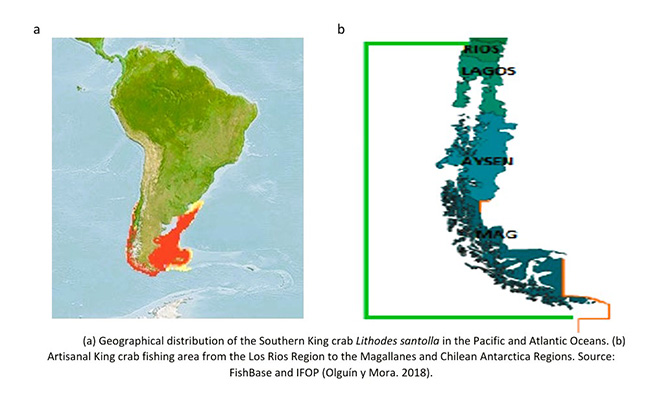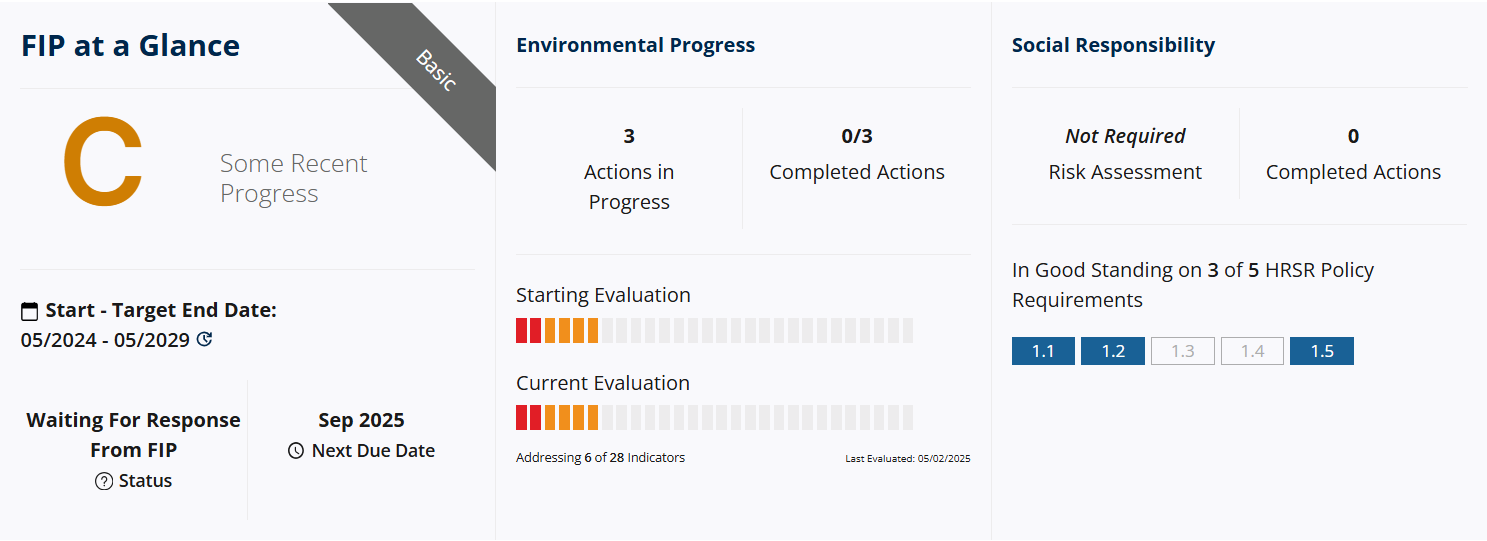Fishery Improvement Project
Last Update: March 2025
Species: Southern King crab (Lithodes santolla)
FIP Profile at FisheryProgress.org: Chile Region XII Southern king crab – pot/trap
Fishery Location: Chilean waters, Region XII. FAO zone: 87.

FIP Coordination:
CeDePesca. If you would like more information about the FIP or if you wish to support it, please contact Gabriela McLean.
FIP Partners:
- Royal Greenland
- CeDePesca (Technical support)
Supporting Documents:
Framework Agreement
Specific Agreement N1 (see Annex I for FIP Action Plan)
FIP Launch / Announced Date: May 2024
Quick view
| Categories: | Whitefish |
| Last Update: | March 2025 |
| Species: | Southern King crab (Lithodes santolla) |
| Fishery Location: | Chilean waters, Region XII. FAO zone: 87 |
Background
The most significant region in terms of Southern king crab landing volumes is the Magallanes and Chilean Antarctica Region, representing until 2007 more than 90% of the total king crab catch at a national level. Over the last few years, it has represented around 75%. Since its onset in 1928 till the early 1960s, the Southern king crab fishery concentrated in the fishing grounds close to Porvenir and Bahía Inútil (north sector of the Great Island of Tierra del Fuego), adding later other harvesting areas such as the Dawson Island, the Seno Almirantazgo, the south of the Brunswick Peninsula and the Seno Otway, limits that were maintained till 1974. In 1975, harvest started in the south area of the region, in the Ballenero Channel and the Beagle Channel. In 1977, the Cape Horn Archipelago was added. During 1979, the geographical coverage of the fishery experienced significant changes, the most remarkable one being the expansion of the harvest activity towards the north of the Magallanes Region. In turn, as new harvest areas were incorporated, landings also increased. In addition to the space variability of the fishing operations in time, a very noticeable feature of this fishery has been the steep decline in landings.
At a national level, the Southern king crab fishery registers four periods since the official statistics began in 1945. A first period from 1945 to 1975, where the annual landings did not exceed 700 t, with an average of 220 t per year. The second period from 1976 to 1999, where despite some variations, landings did not decrease below 1,000 t, with an annual average of 1,823 t. A third period from 2000 to 2010, with landings above 2,000 t, and an annual average slightly above 3,000 t. Finally, a fourth period (2011-2020), whose average annual production exceeded 5,000 t.
The Southern king crab fishery is based in fishing operations performed by independent harvesting vessels, dependent harvesting vessels, and shipping or hauling vessels.
FIP Objectives:
The FIP’s goal is to achieve scores equal to or above 80 points for MSC Performance Indicators in Principle 1 by May 2029.
To that end, the specific objectives of the 5-yr FIP Action Plan are:
- Ensure the adoption of a Management Plan for the Southern king crab fishery in Region XII. The management plan shall set up a harvest strategy that includes explicit short- and long-term objectives (including stock recovery objectives), a harvest control rule, and a provision for the review of the key parts of the system at least once every five years.
- Achieve the adoption of additional management measures that would produce a tailored reduction of fishing effort in such way that the stock of Southern king crab in Region XII is allowed to recover to its target reference point.
- Encourage the improvement of the stock assessment methodology. The improvements include the confirmation of the appropriateness of the reference points for the Southern king crab stock in Region XII, the reduction of uncertainty levels associated to the stock assessment, and the conduction of an external peer review of the assessment methodology.
- Achieve an improvement in the collection of additional data to allow for the estimation of life history parameters specific to the Southern king crab stock in the North Magallanes region and the Central Magallanes region.
- Promote the estimation of IUU catch in the fishery.
- Ensure the FIP is conducted in a socially responsible way, in line with the Conservation Alliance for Seafood Solutions’ guidelines for the implementation of fishery improvement projects.
FIP Activities
2024
May 2024
On 28 May 2024, Royal Greenland and CeDePesca signed a framework agreement setting the general guidelines for the implementation of the Chile Region XII king crab FIP, and Specific Agreement N1 adopting a 5-yr Action Plan and its associated budget.
On the same date, CeDePesca sent a letter to the Chilean Undersecretariat of Fisheries to introduce the FIP and to communicate the FIP goals and the main improvement recommendations derived from the gap analysis against the MSC standard v2.01 conducted by CeDePesca in 2022.
June-September 2024
Regarding the fishery’s management plan, a process of public consultation, held in accordance with Chile’s Fisheries Law, has ended on 30 July 2024. The document, drafted by the fishery’s Management Committee, is now in the process of being formally adopted by Chile’s Undersecretariat of Fisheries (SUBPESCA).
CeDePesca requested meetings with representatives of SUBPESCA’s Crustaceans Unit, SUBPESCA’s Zonal Directorate for Region XII, the Fisheries Research and Development Institute (IFOP), and the Fisheries National Service (SERNAPESCA). In-person meetings took place on August 14th, and virtual meetings took place on August 14th and August 21st. During the meetings, CeDePesca summarized the results of the MSC Pre-Assessment completed in April 2022, presented the FIP Action Plan, offered improvement recommendations, and received valuable feedback from government officials. Follow-up meetings are expected to take place in October, after the fishery’s management plan is adopted by SUBPESCA.
Regarding social responsibility, a Social Policy Statement for the FIP was drafted by CeDePesca and presented to Royal Greenland in June. The statement has been endorsed by International Seafood, supplier of Royal Greenland in Chile, and it applies to all captains and crew members hired by the company to catch and transport Southern king crab in Region XII. In addition, CeDePesca has started interacting with International Seafood to gather the list of vessels associated to the FIP.
2025
January 2025
On May 28th 2024, CeDePesca sent a letter to the Undersecretary of Fisheries presenting the main results of the MSC PA completed in April 2022 and sharing the main improvement recommendations, including the need to establish specific objectives for the recovery of the stock and a harvest control rule that is robust to main uncertainties and responsive to the status of the stock. On June 30th 2024, a draft management plan proposed by the Management Committee for the Southern king crab and Chilean snow crab in the Magellanic and Chilean Antarctica Region (Region XII) was published online by the Undersecretariat of Fisheries (SUBPESCA) for public consultation. In August 2024, CeDePesca had an in-person meeting with the President of the Management Committee of the fishery and SUBPESCA Zonal Director and her technical team to talk in detail about the MSC PA results, improvement recommendations, the FIP and its main tasks and goals. During the meeting, the Management Committee representatives acknowledged the need for an explicit harvest control rule, not included in the draft management plan, and showed their interest in receiving support from the FIP to work on management improvements. After the public consultation phase was over, the draft management plan was turned to a Scientific-Technical Committee to receive feedback, and a final version should be adopted by SUBPESCA soon.
Once a Management Plan for the fishery is adopted by SUBPESCA, the FIP will start working towards a stakeholder consultation to agree on a harvest control rule.
On May 28th 2024, CeDePesca sent a letter to the Undersecretary of Fisheries presenting the main results of the MSC PA completed in April 2022 and sharing the main improvement recommendations, including the need to estimate the volume of illegal catch in the fishery to reduce the level of uncertainty of the stock assessments.
In August 2024, CeDePesca had an in-person meeting with a National Service for Fishing (SERNAPESCA) official in charge of monitoring the Southern king crab fishery in Region XII. During the meeting, CeDePesca informed the official about the MSC PA results, improvement recommendations, the FIP and its main tasks and goals. The SERNAPESCA official explained that illegal practices are being combated by SERNAPESCA, that sanctions exist and are being applied, but the extension of the fishery can complicate surveillance. During the next reporting period, the FIP will promote a discussion on ways to estimate IUU catches that can be incorporated into stock assessments. Also in August, CeDePesca held a virtual meeting with the SUBPESCA officials in charge of the Benthic Crustaceans Unit. During the meeting, topics related to monitoring and surveillance were discussed, as well as topics related to fisheries management and research. The SUBPESCA officials showed their interest in collaborating with the private sector in the improvement of all aspects of the fishery to help it achieve a certifiable status.

